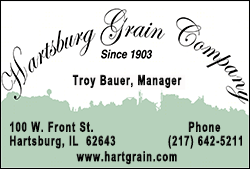|
 The discussion began with city administrator Clay Johnson saying
that the direction received at the last discussion about the park
indicated that aldermen wanted a feasibility study, to determine
where in the city the dog park could be located. He said the
proposal before the council was that Farnsworth be instructed to
look at the Eight Street property, the Third Street property,
currently occupied by the city street department, and Melrose Park.
Melrose Park is located on North Adams Street and appears to be a
city park that is not being utilized by the neighborhood, possibly
because of its close proximity to Ray White Park that offers more
amenities. The discussion began with city administrator Clay Johnson saying
that the direction received at the last discussion about the park
indicated that aldermen wanted a feasibility study, to determine
where in the city the dog park could be located. He said the
proposal before the council was that Farnsworth be instructed to
look at the Eight Street property, the Third Street property,
currently occupied by the city street department, and Melrose Park.
Melrose Park is located on North Adams Street and appears to be a
city park that is not being utilized by the neighborhood, possibly
because of its close proximity to Ray White Park that offers more
amenities.
Johnson said that Farnsworth would conduct the study of all three
locations for a cost of $5,500. He added that the city could
determine if they wanted more than these three, at an added cost, or
less than three at a reduced cost.
Michelle Bauer commented first saying that she had heard what the
Dog Park Committee spokesperson, Brittany McLaughlin, had said at
the last meeting about the Third Street property not being
desirable, and Bauer agreed. She said she thought that location
should be removed from the list.
 Mclaughlin had previously said that the Third Street property was
too close to the railroad tracks and would cause issues for the dogs
in that they could be agitated or startled by the trains. Jonie
Tibbs agreed the trains could cause panic that might lead to
behavioral issues that would be unsafe.
McLaughlin was in attendance at the Tuesday night meeting, along
with several of her committee members. Rick Hoefle asked McLaughlin
to confirm that the committee plans to raise the money to build the
park, but that they want the city of pay for this initial study.
McLaughlin came forward and confirmed, the study is being done to
determine what property the city would give over to the project.
Once the committee knows where the park will be located, it will
immediately begin fundraising efforts to cover the cost of
construction. She told the council that the committee wants to
self-fund the project, but that they would certainly accept
financial support from the city to go along with that.
She added that the first step would be to raise the funding for the
fence and two water fountains.
McLaughlin also commented on the Third Street location, saying
indeed that was not a good option, and the committee would not
commit to raising funds and constructing a park on that particular
property.
She said the committee had looked at Melrose Park as well and had
concerns. She said the park was approximately one acre, and in the
opinion of the committee, too small for a proper dog park. In
addition, she said there was playground equipment in the park that
would have to be removed, and the committee didnít want to pay the
cost of removal. Finally, she said the park has too much shade, and
that it would end up being a muddy park for the dogs.
She concluded that for the committee, the property they are set on
utilizing is the Eighth Street property.
Jeff Hoinacki said he felt that the Third Street property should be
included in the study. He noted that the Logan County Animal Control
is located close to the railroad as is the Humane Society of Logan
County, and they donít appear to have any problems. McLaughlin said
that in both of those examples, there are no open dog runs. She said
dogs are let out into individual runs, where they donít have an
opportunity to interact with other dogs.
She punctuated her objection to the Third Street property saying
that the committee would not support that location, nor fundraise
for it. If the city chose to build the park on Third, it would do so
at its own expense.
 Steve Parrott said at the last meeting, he had asked for an estimate
of how many dogs lived in the city of Lincoln, and the answer was
not available. He wanted to know if McLaughlin had that answer now.
McLaughlin said she had made numerous attempts to gather that
information through the county but had not been successful. He
wondered how the committee could know that one acre at Melrose was
too small if it didnít know how many dogs there could be using the
park. McLaughlin said the size of the park was not necessarily based
on the number of dogs that would be there, but rather it was based
on dog park studies that indicated two acres was the best size for a
park with two areas; one for large dogs, one for small dogs.
She reiterated that Melrose, at only one acre was too small. She
added that the fencing would have to be set in, and there would need
to be sidewalk work, so the acre would end up being much less by the
time the park was completed.
[to top of second column] |

Todd Mourning asked if there would be vacant space at the new street facility
that could be utilized. Johnson said yes there would be, but using it for a dog
park would be difficult because the city will have security fences and locked
gates at the new facility. He said there would have to be extra fencing put up
by the city to secure the street department assets, and it would still not be
the ideal situation.
Bauer said that she felt the aldermen had a responsibility to the people of
Lincoln to look at options for the park location. She said that while the Apex
Outdoor Health Complex design is something the city cannot afford to go forward
with at the moment, it was still something the community wanted, and the city
needed to be mindful of the desires of its constituents.
McLaughlin said that if Farnsworth had experience with dog parks, as indicated
earlier by Johnson, then she felt the city should let Farnsworth do the work,
and come back with the recommendation. She added that the committee wanted an
opportunity to work with Farnsworth in their study. She repeated that including
the Third Street location would be a waste of money for the city because it is
not a location the committee would support.
Rick Hoefle said that the city did need to be mindful of what the Apex was
originally designed to be for the city and that just because there wasnít money
now, that didnít mean there wouldnít be in the future. He asked McLaughlin if
the committee would accept half of the Eight Street property as its dog park,
and leave the other half for the Apex. Half of the property would be about one
and a half acres.
McLaughlin said the committee had considered that split. At this point, she
thought the best idea would be to let Farnsworth do their study and see what
they come back with on land use requirements.
The discussion moved on to revenue versus expenses, with Hoefle asking if the
membership fees would cover maintenance of the property. Once the park is
constructed, it will be up to the city to maintain the property and provide the
water and electric if and when it is installed. The thought is that the annual
membership would cover the cost of this maintenance. Johnson said that the
membership might cover the cost, but that there would be no profit for the city,
and even break-even might be difficult.

McLaughlin said that wasnít much of an issue because the city is currently
paying to mow the property, so there is no true additional cost added, except
water and electric, which she said did not have to be added right away, those
amenities could come later. She concluded that right now, all the park needed to
open was a fence. Cleaning the park and trash collection were mentioned, and
McLaughlin said the committee would seek volunteers to keep the park clean.
The question then came; if the park loses or has no membership, and cannot
support itself, what happens then? McLaughlin said that was a conversation that
would have to take place if the problem arose. At the same time, she added the
committee needed some assurances that the park would not be closed by the city
if money came along to finish the Apex.
Hoefle asked an additional two times if the committee would accept a design
utilizing only half of the Apex property. The second time, McLaughlin hedged on
the question, but the third time she said that if that were what Farnsworth
supported, and what the city was willing to give, yes, the committee would
accept it.
In the end, it appeared that Melrose was off the table as a possible option and
that Farnsworth will be asked to do a study that would utilize one-half of the
Apex at City Center property for the Central Bark Dog Park. The council will
still need to approve a motion at the next voting session to be held on Monday,
November 21st.
[Nila Smith]

 |